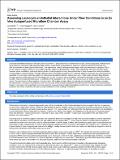| dc.contributor.author | Mulki, Lama | en_US |
| dc.contributor.author | Sweigard, J. Harry | en_US |
| dc.contributor.author | Connor, Kip M. | en_US |
| dc.date.accessioned | 2015-04-01T15:30:37Z | |
| dc.date.issued | 2014 | en_US |
| dc.identifier.citation | Mulki, Lama, J. Harry Sweigard, and Kip M. Connor. 2014. “Assessing Leukocyte-endothelial Interactions Under Flow Conditions in an Ex Vivo Autoperfused Microflow Chamber Assay.” Journal of Visualized Experiments : JoVE (94): 52130. doi:10.3791/52130. http://dx.doi.org/10.3791/52130. | en |
| dc.identifier.issn | 1940-087X | en |
| dc.identifier.uri | http://nrs.harvard.edu/urn-3:HUL.InstRepos:14351326 | |
| dc.description.abstract | Leukocyte-endothelial interactions are early and critical events in acute and chronic inflammation and can, when dysregulated, mediate tissue injury leading to permanent pathological damage. Existing conventional assays allow the analysis of leukocyte adhesion molecules only after the extraction of leukocytes from the blood. This requires the blood to undergo several steps before peripheral blood leukocytes (PBLs) can be ready for analysis, which in turn can stimulate PBLs influencing the research findings. The autoperfused micro flow chamber assay, however, allows scientists to study early leukocytes functional dysregulation using the systemic flow of a live mouse while having the freedom of manipulating a coated chamber. Through a disease model, the functional expression of leukocyte adhesion molecules can be assessed and quantified in a micro-glass chamber coated with immobilized endothelial adhesion molecules ex vivo. In this model, the blood flows between the right common carotid artery and left external jugular vein of a live mouse under anesthesia, allowing the interaction of native PBLs in the chamber. Real-time experimental analysis is achieved with the assistance of an intravital microscope as well as a Harvard Apparatus pressure device. The application of a flow regulator at the input point of the glass chamber allows comparable physiological flow conditions amongst the experiments. Leukocyte rolling velocity is the main outcome and is measured using the National Institutes of Health open-access software ImageJ. In summary, the autoperfused micro flow chamber assay provides an optimal physiological environment to study leukocytes endothelial interaction and allows researchers to draw accurate conclusions when studying inflammation. | en |
| dc.language.iso | en_US | en |
| dc.publisher | MyJove Corporation | en |
| dc.relation.isversionof | doi:10.3791/52130 | en |
| dc.relation.hasversion | http://www.ncbi.nlm.nih.gov/pmc/articles/PMC4354482/pdf/ | en |
| dash.license | LAA | en_US |
| dc.subject | Bioengineering | en |
| dc.subject | Issue 94 | en |
| dc.subject | Leukocyte recruitment | en |
| dc.subject | endothelium | en |
| dc.subject | flow chamber | en |
| dc.subject | adhesion | en |
| dc.subject | velocity | en |
| dc.subject | rolling | en |
| dc.subject | integrins | en |
| dc.subject | | en |
| dc.title | Assessing Leukocyte-endothelial Interactions Under Flow Conditions in an Ex Vivo Autoperfused Microflow Chamber Assay | en |
| dc.type | Journal Article | en_US |
| dc.description.version | Version of Record | en |
| dc.relation.journal | Journal of Visualized Experiments : JoVE | en |
| dash.depositing.author | Connor, Kip M. | en_US |
| dc.date.available | 2015-04-01T15:30:37Z | |
| dc.identifier.doi | 10.3791/52130 | * |
| dash.contributor.affiliated | Connor, Kip | |


